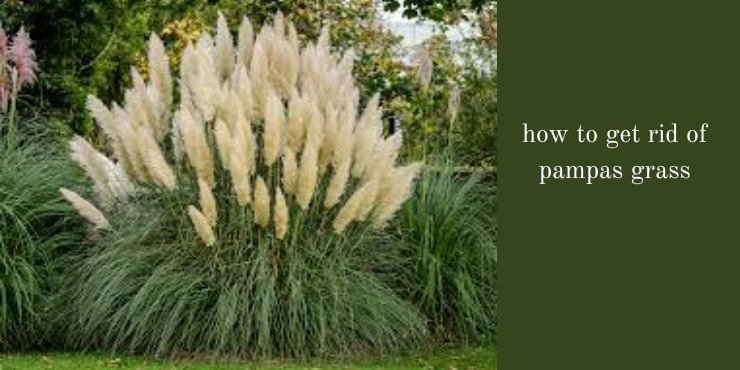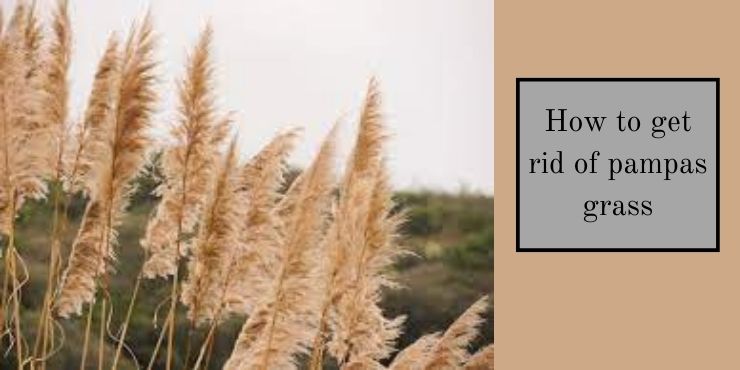How to get rid of pampas grass
How to get rid of pampas grass, with its striking plume-like flowers and tall, feathery fronds, can add a touch of elegance to any landscape. However, it’s essential to remember that this ornamental grass can become invasive, taking over your garden and displacing native plants. In some cases, it may be necessary to remove pampas grass from your property. In this article, we’ll explore various strategies to effectively get rid of pampas grass while maintaining the health and aesthetics of your garden.
Understanding Pampas Grass
Before diving into the removal process, it’s essential to understand the nature of pampas grass. Pampas grass (Cortaderia selloana) is native to South America and is known for its rapid growth and prolific seed production. Its roots can run deep, making it a challenging weed to eradicate. Here are some effective methods for removing pampas grass from your property

Manual Removal
Manual removal is a practical and environmentally friendly method for eliminating pampas grass (Cortaderia selloana) from your garden. This technique is beneficial for small infestations or when dealing with younger pampas grass plants. Below, we provide a step-by-step guide on manually removing pampas grass from your property.
Materials and Tools You’ll Need:
- Protective clothing: Wear gloves, long sleeves, and pants to shield yourself from the sharp leaves and potential skin irritation.
- A sharp spade or shovel: This will be your primary tool for digging up the grass.
- Trash bags or containers: For collecting and disposing of the removed pampas grass.
Step 1: Preparation Before you begin, make sure you’re adequately dressed in protective clothing. Pampas grass leaves are known for their sharp edges, which can be abrasive to the skin.
Step 2: Dig Around the Base Use your sharp spade or shovel to dig around the base of the pampas grass plant. The objective is to reach as deeply as possible into the soil around the roots. Start by making a circular cut around the grass clump, gradually loosening the soil.
Step 3: Lift and Remove the Plant Once you’ve successfully loosened the root system, attempt to lift the entire pampas grass plant out of the ground, roots and all. This step may require some effort, as pampas grass can have deep and extensive root systems.
Step 4: Disposal Dispose of the removed pampas grass responsibly to prevent its re-establishment on your property. Seal it in trash bags or containers, and consider labeling it as “invasive plant waste” to ensure proper handling.
Step 5: Post-Removal Care After removing the pampas grass, it’s essential to monitor the area for any potential regrowth. Even though manual removal is effective, there might still be pampas grass seeds in the soil that can sprout in the future.
Tips:
Manual removal is most effective during the plant’s active growth phase when the soil is relatively moist and easy to work with. Larger and more established pampas grass plants may require more effort to remove manually. In such cases, consider seeking professional assistance.
By following these steps for manual removal, you can take control of pampas grass infestations in your garden and help maintain a healthier and more balanced landscape.

Chemical Control
When dealing with more extensive pampas grass infestations, chemical control methods can be a practical and efficient solution. This approach involves using herbicides to eliminate pampas grass, which can be especially useful when manual removal is not feasible. Here, we describe the chemical control method for pampas grass:
- Herbicide Selection: The first step in chemical control is to choose the right herbicide for pampas grass. Select an herbicide specifically formulated for controlling grassy weeds, as pampas grass is a grass-like plant. Ensure that the herbicide you choose is safe for the other plants in your garden.
- Application Timing: To maximize the effectiveness of herbicide treatment, it’s crucial to apply it during the active growth phase of pampas grass. Typically, this is during the growing season, which may vary depending on your geographical location and climate. Be sure to follow the manufacturer’s instructions regarding the correct timing for application.
- Protective Gear: When applying herbicides, it’s essential to protect yourself. Wear appropriate protective clothing, including gloves, long sleeves, pants, and safety goggles. This gear will help safeguard you from any potential exposure to the herbicide.
- Application Method: Herbicides can be applied using various methods, such as sprayers, wipers, or paintbrushes. The choice of application method may depend on the specific herbicide and the size of the pampas grass infestation. Follow the manufacturer’s instructions regarding the application method and herbicide concentration.
- Targeted Application: Ensure that the herbicide is applied directly to the pampas grass you want to eliminate. Avoid over-spraying or allowing the herbicide to come into contact with desirable plants.
- Post-Treatment Care: After applying the herbicide, monitor the pampas grass for signs of wilting and eventual dieback. It may take some time for the herbicide to take effect. As the pampas grass begins to show signs of decline, you can cut back the dead or dying foliage to prevent seed formation and enhance the aesthetic appeal of your garden.
- Disposal: Dispose of any pruned pampas grass carefully, ensuring it doesn’t re-establish itself. Burning or sealing the plant waste in bags marked “invasive plant material” is a suitable method.
- Repeat if Necessary: In some cases, pampas grass may require multiple herbicide applications to completely eradicate it. Follow-up treatments may be necessary, especially for larger or more persistent infestations.
Professional Assistance: If you are unsure about herbicide selection or application, or if you are dealing with a substantial pampas grass infestation, consider seeking professional assistance from a landscaper or gardening expert who has experience with herbicide application.
By following these guidelines for chemical control of pampas grass, you can effectively manage this invasive plant and restore balance to your garden or landscape. Remember to always follow the manufacturer’s instructions on the herbicide label for safe and efficient application.
Cutting and Burning
Pampas grass (Cortaderia selloana) can be a striking addition to your landscape, but if it’s becoming invasive and taking over your garden, cutting and burning is a practical method to control and prevent further spread. This technique focuses on removing the plant’s plume-like flowers and foliage, which are responsible for seed production. Below is a description of the cutting and burning method for managing pampas grass effectively:
- Timing is Crucial: The key to successful cutting and burning is timing. Keep a close eye on your pampas grass plants, especially during the late summer and early fall when they produce their distinctive plumes of flowers. This is the ideal time to act.
- Gather Your Tools: To execute the cutting and burning method, you’ll need the following tools and materials:
- Pruning shears or a saw for cutting.
- A safe and designated area for burning, such as a fire pit.
- A fire source (e.g., matches or a lighter).
- Safety gear, including gloves and protective clothing.
- Cut the Plumes: Begin by cutting the plume-like flowers and fronds from the pampas grass using pruning shears or a saw. Ensure that you remove the entire plume, as it’s the part responsible for seed production. Collect the cuttings in a container for later disposal.
- Safely Burn the Cuttings: After removing the plumes and foliage, safely burn them in a designated area, such as a fire pit. Burning is an effective way to destroy the seeds and prevent the pampas grass from spreading. Ensure that the fire is controlled and complies with local regulations.
- Post-Burning Cleanup: After the burning process, allow the ashes to cool and collect them for disposal. Be sure that no live seeds or plant material remain in the ashes.
- Dispose of Cuttings and Ashes: Dispose of the cuttings and ashes responsibly, ensuring they won’t re-establish pampas grass on your property. It’s advisable to label the disposal container as “invasive plant waste.”
- Repeat as Needed: Pampas grass may produce new plumes and foliage throughout its growing season. Regularly monitor your plants and repeat the cutting and burning process as necessary to prevent seed formation and further growth.
- Be Mindful of Safety: Exercise caution during the cutting and burning process, especially when dealing with fire. Ensure that you adhere to safety guidelines and local regulations regarding open burning.
Note: Cutting and burning can be a valuable method for managing pampas grass, particularly in preventing seed production and controlling its spread. However, it may not completely eradicate established plants. For larger infestations or complete removal, consider combining this method with manual removal or herbicide application, if appropriate.
By incorporating the cutting and burning method into your pampas grass management strategy, you can effectively maintain a healthier and more controlled garden or landscape.
Conclusion
How to get rid of pampas grass can be a beautiful addition to your garden, but when it becomes invasive, it’s essential to take action to remove it effectively. Whether you choose manual removal, chemical control, or a combination of methods, the key is to be persistent and monitor the area for any regrowth. By following these strategies, you can regain control of your garden and prevent pampas grass from taking over your property. Remember that each removal method has its pros and cons, so choose the one that best fits your specific situation and gardening preferences.


